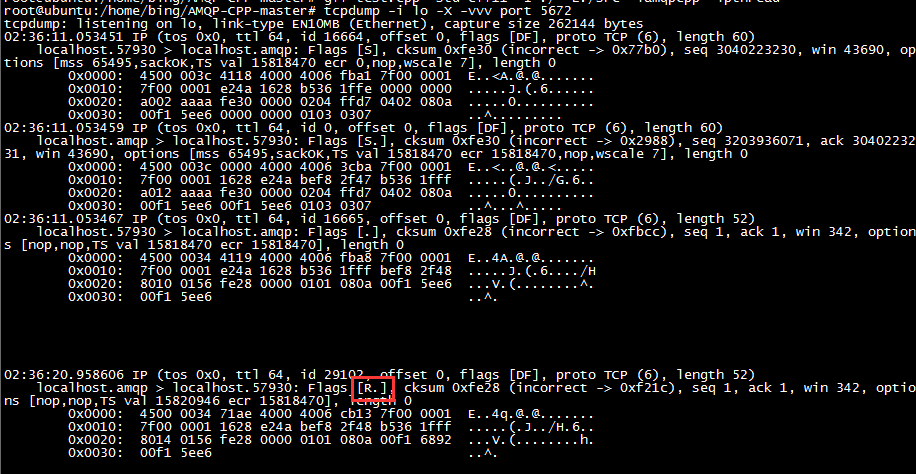使用RabbitMQ时,连接rabbit-server一直连接失败,代码没有任何错误提示。但是通过rabbitmqctl始终查询不到连接以及创建的queue等信息。
官方的文件demo里面也没有TcpConnection相关例子,只在github上有些简单说明。
然而网上几乎所有人都依然还是在使用Connection,几乎没有使用TcpConnection的例子。最后还是放弃了网络求助,老老实实看源码定位了。
使用tcpdump确认,代码这边的TcpConnection确实是已经向rabbit-server发出了连接请求。
开始观察发现三次握手是已经建立了连接的,但是几秒后,rabbit-server主动发送返回了一个RST包。这非常诧异,查看rabbit-server日志看到,产生了一次handshake_timeout错误。
现在可以确认,不是鉴权产生的问题,而是在连接时就已经失败了,在完成连接到RST包收到刚好过了10s时间。在官方文档查阅到,rabbit-server的心跳也刚好是10s。
后来还是确定问题点是在代码上,但是代码只有短短几行从github上copy下来的,怎么会出错呢。
最后在日志打印上发现monitor函数执行了两次,这个小小的信息感觉看到了问题的原因,查看TcpConnection源码monitor被调用的地方。
1 public: 2 /** 3 * Constructor 4 * @param connection Parent TCP connection object 5 * @param socket The socket filedescriptor 6 * @param buffer The buffer that was already built 7 * @param handler User-supplied handler object 8 */ 9 TcpConnected(TcpConnection *connection, int socket, TcpOutBuffer &&buffer, TcpHandler *handler) : 10 TcpState(connection, handler), 11 _socket(socket), 12 _out(std::move(buffer)), 13 _in(4096) 14 { 15 // if there is already an output buffer, we have to send out that first 16 if (_out) _out.sendto(_socket); 17 18 // tell the handler to monitor the socket, if there is an out 19 _handler->monitor(_connection, _socket, _out ? readable | writable : readable); 20 } 21 22 /** 23 * Destructor 24 */ 25 virtual ~TcpConnected() noexcept 26 { 27 // we no longer have to monitor the socket 28 _handler->monitor(_connection, _socket, 0); 29 30 // close the socket 31 close(_socket); 32 }在构造和析构中各调用了一次,而且内部使用connection可能是为了提高效率进行了线程操作,也就是说实际的connection是在多线程中完成的。
最后尝试修改代码,使用指针进行操作,因为代码并不是github上的单个函数文件,而是多处引用,最后问题解决。成功使用TcpConnection连接上了rabbit-server。
附上简单代码:
1 int Broker::init(std::string host,int port, std::string username, std::string userpasswd, int svrid) 2 { 3 // create an instance of your own tcp handler 4 _handle = new DSBrokerMessageHandle(); 5 6 // address of the server 7 AMQP::Address address(host, port,AMQP::Login(username,userpasswd),"/"); 8 9 // create a AMQP connection object 10 _connection = new AMQP::TcpConnection(_handle, address); 11
12 // and create a channel 13 _channel = new AMQP::TcpChannel(&connection); 14 15 auto receiveMessageCallback = [=](const AMQP::Message &message, 16 uint64_t deliveryTag, 17 bool redelivered) 18 { 19 //_channel->ack(deliveryTag); 20 }; 21 22 AMQP::QueueCallback callback = 23 [=](const std::string &name, int msgcount, int consumercount) 24 { 25 _channel->bindQueue("service", name, name); 26 _channel->bindQueue("service", name, "monitor"); 27 _channel->bindQueue("service", name, "heartbeat"); 28 29 _channel->consume(name, AMQP::noack).onReceived(receiveMessageCallback); 30 }; 31 32 AMQP::SuccessCallback success = [svrid, this, callback]() 33 { 34 char que[4] = { '\0' }; 35 ACE_OS::itoa(svrid, que, 10); 36 std::string quename(que); 37 _channel->declareQueue(quename, AMQP::durable).onSuccess(callback); 38 }; 39 40 // use the channel object to call the AMQP method you like 41 _channel->declareExchange("service", AMQP::fanout).onSuccess(success); 42 43 return 0; 44 }




